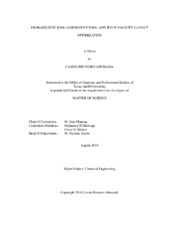| dc.description.abstract | The severity of several chemical incidents occurred in the recent past has been attributed to improper layout arrangement or proximity of a chemical facility to a densely populated area although this is not a new problem. To address this problem, researchers have been considering not just economic efficacy but also safety features in layout optimization. Therefore, there is still a need for a comprehensive risk assessment methodology in combination with the layout optimization formulation. Moreover, risk probability distributions should be employed to enhance understanding of overall risks and to support decision making during the design phase. The objective of this study is to incorporate a probabilistic risk assessment into the design optimization formulation. The methodology was divided in three main parts.
First, a risk assessment program has been developed in MATLAB to estimate risks associated with human life losses and structural damage in a chemical plant. Analytical models for fire and explosion scenarios and toxic chemical releases were included in the program. Monte Carlo simulation was then employed to propagate uncertainties attributed to environemtal conditions and release paramenters. The proposed program generates risk maps and risk distributions at a particular point of interest in a timely manner.
Second, domino effect concepts have been included in the resulting program to obtain minimal separation distances between process units necessary to prevent escalation events. These distances vary according the targeted unit type, escalation vector (overpressure or fire impigement) and the risk acceptability criteria.
In the last stage, risk maps and safety distances are included in a mixed-integer linear programming (MILP) for layout optimization. The objective function is set to minimize the total capital cost associated with structural damage risk, fatality risk, pipeline interconnection, and protective devices. Individual risk criteria was applied as an additional constraint for high occupancy buildings, meaning that the overall risk for buildings such as control room or lab may not exceed this criterion.
The proposed methodology has been demonstrated through a case study. It enhanced flexibility during the layout arrangement allowing the user not just include site-specific data but also the risk acceptance criteria, which reflects the company’s safety culture. | en |


